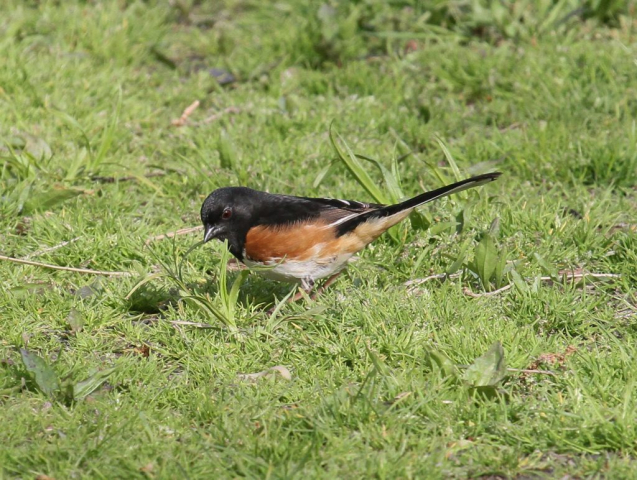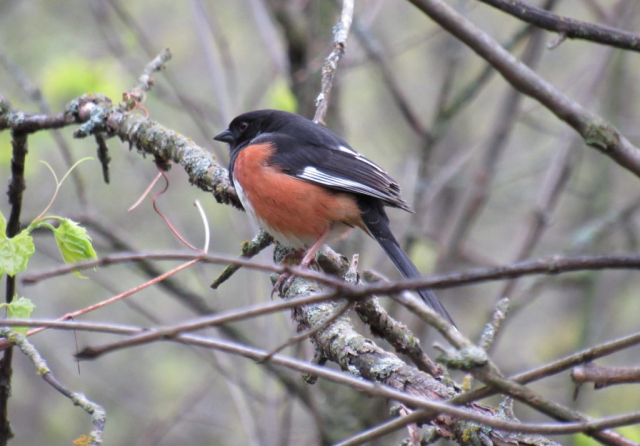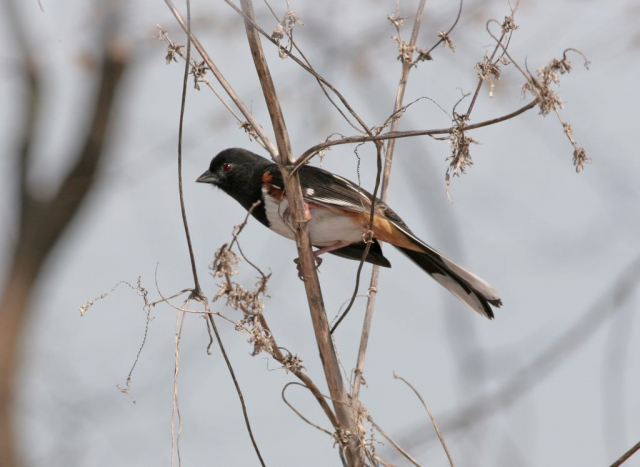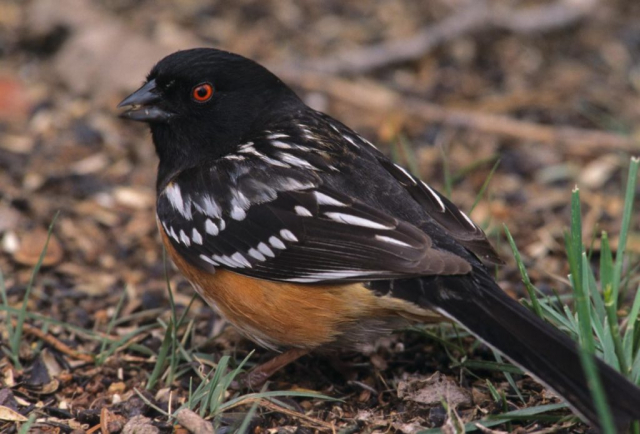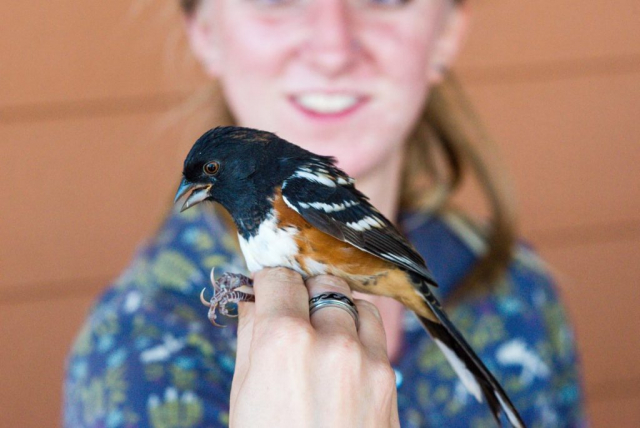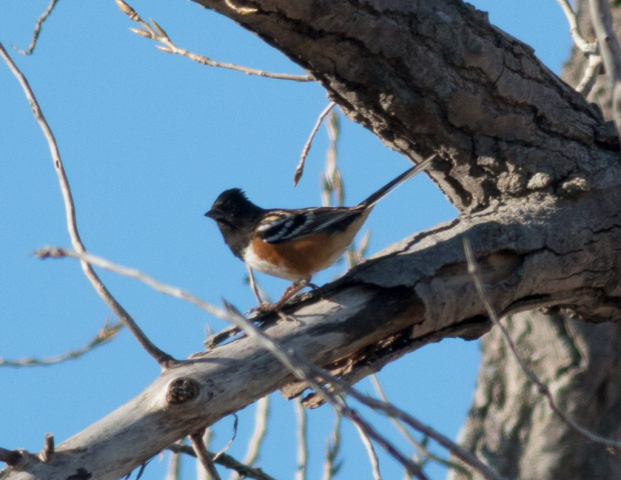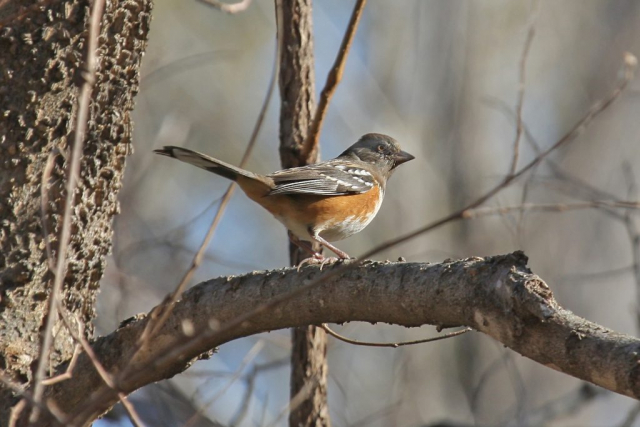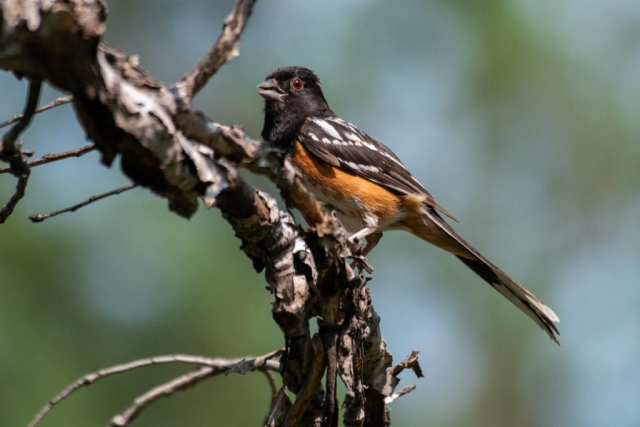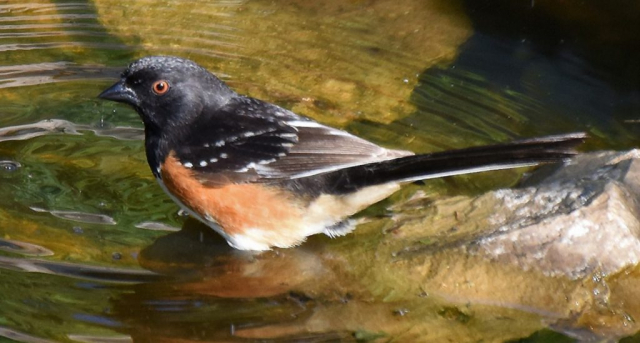Pipilo maculatus x erythrophthalmus
Status: Uncommon summer resident central and east, rare west.
Taxonomy: It has been assumed that hybridization and/or introgression occurs statewide, but the relative contributions of genetics and adaptation (controlled presumably by assortative mating) to the distributions of phenotypic Eastern and Spotted Towhees and putative intergrades is unknown. There have been no genetic studies of this area of species overlap in Nebraska.
Summer: Apr 17, 19, 19 <<<>>> Oct 11, 12, 14
Earlier dates are 14 Mar 2019 Kearney Co, 18 Mar 2022 Hall Co, 25 Mar 2011 Sarpy Co, 28 Mar 2021 Lancaster Co, 31 Mar 2024 Branched Oak Lake, Lancaster Co, 9 Apr 2012 Buffalo Co, 12 Apr 2024 Frontier Co, and 13 Apr 2025 Lancaster Co.
Later dates are 17 Oct 2020 Hall Co, and 30 Oct 2024 Lancaster Co.
There are no records from Nov-early Mar.
Spring dates (Mar-May) suggest migration northward and westward coincident with spring movement of Spotted Towhee (eBird.org, accessed Jun 2024). There are no records Nov-Feb.
One was carrying food 22 Jun 2024 in Hall Co.
This hybrid is commonly reported in the central US, and as might be expected in summer, most records are concentrated in Nebraska, particularly in central Nebraska (eBird.org, accessed Jun 2024). An example is the seven reports for Jun-Jul 2024, all of which were along the Platte River Valley between Grand Island and Ogallala.
Comments: It is clear that more study of the distributions of Eastern and Spotted Towhees in the breeding season in Nebraska is needed. In the absence of genetic studies, it is unknown what proportion, if any, of “spotted-backed” towhees reported to eBird as Spotted Towhees might be introgressants, a point noted by Scharf (2005), who focused on phenotypic Eastern Towhees in his study because birds with any degree of white spotting on their upperparts were likely to be of indeterminate genotype. If Spotted and Eastern Towhees are “good” species, genetically distinct, interbreeding would be expected to be minimal, and mitigated against by assortative mating in areas of overlap. Sibley and West (1959) suggested that one factor leading to assortative mating might be correlation of degree of back spotting pattern with climatic differences, in particular the amount of shade in towhee habitat (more in eastern forests than in western open brush). In this context, Walsh et al (2020), in a study of hybridization between Bullock’s and Baltimore Orioles in Nebraska, found that hybrid zone width estimates differed between genomic and plumage data, the latter more narrow, and suggested that one explanation might be that selection pressure could be stronger on phenotypic traits. Anecdotal information supporting this theory was provided by T. J. Walker (personal communication), who observed that in his southeastern Lincoln County, Nebraska survey area “I have noted for years that the [Spotted Towhee] songs vary quite a bit – in areas with more deciduous woodland and cedar coverage most of the songs, while still typical of Spotted, have a little hint of “Eastern” to them. In the areas of the canyons with very little woodland, where the landscape is mostly grassland with shrub thickets the songs are quite “dry” and clearly Spotted.” Similarly, in 2020 two southeasterly reports of Spotted Towhees were from a prairie and a golf course, both in Saunders Co. These considerations raise the possibility that towhees of apparent intermediate plumages and songs are not necessarily (genetic) introgressants, but might include individuals of sub-populations distributed regionally that have adapted over time to local environmental conditions. If this is true, and introgressants occur in relatively low numbers, the distribution across Nebraska of the degree of back and wing spotting and wing patch extent would be expected to be clinal in both species, reflecting local environmental conditions while maintaining genetic integrity of Spotted and Eastern Towhees. Since songs are learned in these species, mixed songs are to be expected in areas of overlap. Although Sibley and West (1959) pointed out that contact between Spotted and Eastern Towhees in Nebraska was not on a broad front but limited to riparian corridors and surmised that this resulted in “greatly restricted” gene flow, the latter is likely to be largely a consequence of assortative mating, as suggested by these same authors.
Images
Literature Cited
Scharf, W.C. 2005. New westward breeding records for Eastern Towhees in Central Nebraska. NBR 73: 26-28.
Sibley, C.G., and D.A. West. 1959. Hybridization in the Rufous-sided Towhees of the Great Plains. Auk 76: 326-328.
Walsh, J., S.M. Billerman, V.G. Rohwer, B.G. Butcher, and I.J. Lovette. 2020. Genomic and plumage variation across the controversial Baltimore and
Bullock’s oriole hybrid zone. Auk 137: 1–15. DOI: 10.1093/auk/ukaa044.
Recommended Citation
Silcock, W.R., and J.G. Jorgensen. 2025. Spotted x Eastern Towhee (hybrid) (Pipilo maculatus x erythrophthalmus). In Birds of Nebraska — Online. www.BirdsofNebraska.org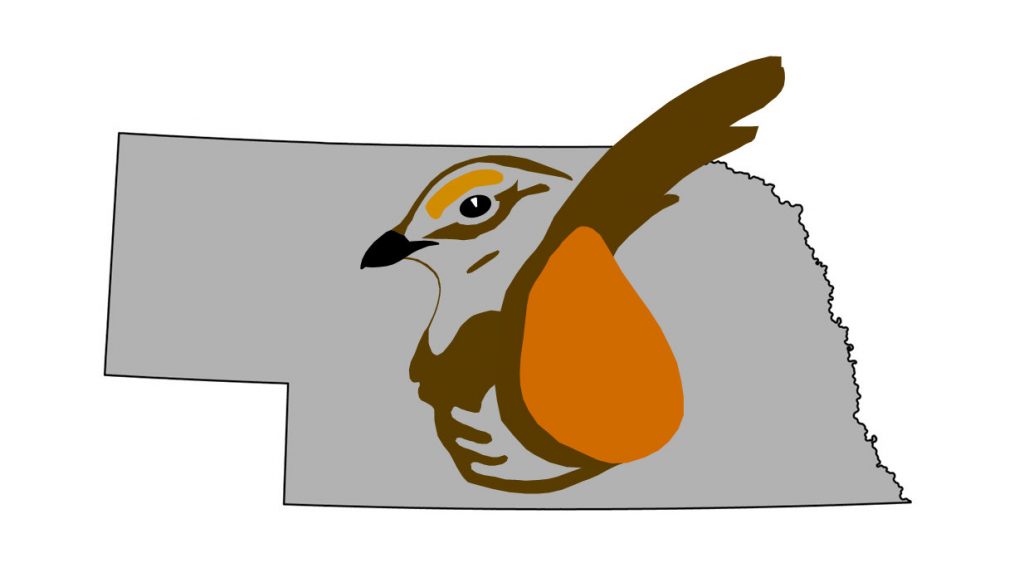
Updated 24 Jun 2025
